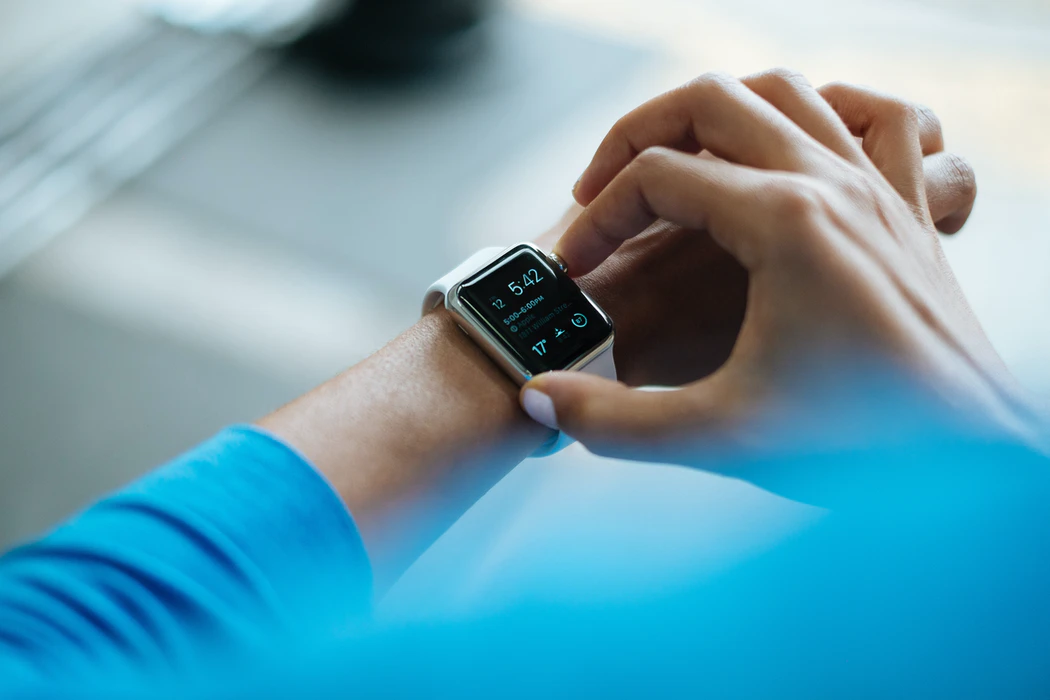
How Apple Connected Devices Work To Improve Healthcare
In this article, we will explore Apple in healthcare zeroing in on how Apple’s connected devices are revolutionizing the healthcare landscape by facilitating the world with powerful and intuitive tools.
Apple, a pioneer in innovation, has made significant strides in improving healthcare through its connected devices.
Over the years, we’ve seen Apple establish a comprehensive ecosystem of applications and software in several fields. However, it has demonstrated remarkable progress in the healthcare field, particularly in terms of its hardware offerings. Third-party app developers have also worked on some remarkable Mobile app ideas for healthcare that have helped in revolutionizing the health field.
By empowering app developers, enhancing patient care, and promoting proactive health management, Apple is reshaping the way we approach healthcare.
Undoubtedly, the integration of technology into healthcare, more specifically, the use of Apple devices in the medical field has ushered in a new era of possibilities.
Let’s dive into the intricate details:
In this digital landscape, Apple devices have emerged as powerful tools, revolutionizing the medical field with their innovative features and user-friendly interfaces.
The use of Apple devices in the medical field benefits both patients and healthcare professionals by transforming iOS devices into essential tools for monitoring health, accessing medical records, and facilitating seamless communication between healthcare providers.
These devices have enabled remote patient monitoring, telemedicine consultations, and streamlined workflows, leading to improved patient care and enhanced efficiency.
Let’s explore how each iOS device serves as an ideal health companion for its users:
1. Apple Watch: Your Holistic Health Guardian
The Apple Watch goes beyond being just a timepiece. It is a remarkable example of wearable technology that has transformed into the perfect holistic health guardian for its users.
With Apple Watch’s medical features, it can provide comprehensive support to both users and patients across various facets of health. From heart health and mobility to activity tracking and medication management, the Apple Watch sweeps up all accolades for Apple in healthcare.
Amidst the multitude of apps that make valuable contributions, Apple Watch stands out from its competitors due to these three distinct features:
i. Heart Rate Notifications
The Apple Watch Heart Rate Notifications offer three key features:
- Continuous Background Monitoring: Diligently monitors heart rates, even during inactivity, allowing early detection of abnormal rates that may signify underlying health concerns.
- Customizable Thresholds: Users have the flexibility to set their own heart rate thresholds. If the heart rate exceeds or falls below the predefined threshold during a period of inactivity, the user receives a notification.
- Centralized Monitoring and Data Viewing: Monitor heart rate notifications, including date, time, and readings, are easily accessible and reviewable within the Health app on the user’s iPhone.
By leveraging these heart health notifications, Apple in healthcare ensures that potential cardiac concerns are promptly identified and addressed, promoting proactive healthcare management for improved patient outcomes.
ii. Irregular Rhythm Notifications
The Apple Watch Irregular Rhythm Notifications offer three main features:
- Detection of Irregular Rhythms: Periodically checks for irregular heart rhythms that could be indicative of atrial fibrillation (AFib).
- Optical Heart Sensor Analysis: Detects the pulse wave at the wrist and identifies variability in beat-to-beat intervals when the user is at rest.
- Timely Notifications and Record-Keeping: If the algorithm consistently detects irregular rhythms indicative of AFib, the user receives a notification. Additionally, the Health app records the date, time, and beat-to-beat heart rate for future reference and comprehensive analysis.
The combined functionality of these features empowers Apple healthcare users to stay updated on their heart health, identify possible irregular rhythms, and seek necessary guidance from professionals for further evaluation and care.
iii. ECG App
The Apple Watch ECG app offers three main features:
- Electrocardiogram (ECG) Recording: Allows users to record a single-lead ECG by simply placing their finger on the Digital Crown. This feature enables users to capture and analyze their heart’s electrical activity.
- Heart Rhythm Classification: Classify the recorded heart rhythm as either sinus rhythm or atrial fibrillation.
- Detailed Heart Data Analysis: Conveniently review recorded ECG data, including heart rate information, within the Health app on their iPhone.
With these features, Apple in Healthcare provides users with a convenient tool for monitoring their heart health, detecting abnormal rhythms, and generating valuable data for better healthcare management.
2. iPhone and Health App: Your Personal Health Hub
From centralized health data storage to telehealth capabilities, these tools empower individuals and healthcare providers, facilitating more personalized and efficient care delivery. This has also lead to many Healthcare app development services to appear on the scene, who have created life saving apps over the past decade.
Apple in healthcare begins with iPhone and Health app, supporting the healthcare system in several ways:
- Centralized Health Data: Functions as a secure central hub for users to store and access health-related data, including medical records, lab results, medications, and vital signs.
- Remote Monitoring and Telehealth: Enable healthcare providers to remotely monitor patients’ health conditions, track vital signs, collect symptom data, and conduct virtual consultations.
- Research and Insights: Supports medical research and population health studies by allowing users to participate in research programs through the ResearchKit framework.
- Wellness and Self-care: Offers activity tracking, sleep analysis, mindfulness apps, and personalized health insights, empowering individuals to take proactive steps toward better health management and preventive care.
Overall, the integration of the iPhone and Health app into the healthcare system enhances data accessibility, remote monitoring capabilities, and research opportunities.
3. iPad: Modernizing Medical Practice
Apple in healthcare is revolutionizing the medical practice with iPad.
From efficient documentation and enhanced communication to point-of-care education and advanced imaging, an iPad delivers patient care, promotes cross-collaboration, and facilitates access to vital information.
- Efficient Documentation: Professionals can access electronic health records (EHRs) and document patient information directly at the point of care.
- Enhanced Communication: Healthcare providers can securely communicate and collaborate with their colleagues, nurses, and other members of the care team.
- Point-of-Care Education: Provides healthcare professionals with immediate access to medical references, textbooks, and educational resources.
- Medical Imaging and Visualization: Offers advanced imaging and visualization capabilities, enabling healthcare providers to review and interpret medical images such as X-rays, CT scans, and MRIs.
- Telemedicine and Remote Consultations: Supports telemedicine initiatives, allowing healthcare providers to conduct virtual consultations with patients remotely.
The iPad modernizes medical practice by streamlining documentation, improving communication, facilitating access to educational resources, supporting medical imaging, and enabling telemedicine.
This empowers healthcare professionals to deliver patient-centered care effectively and efficiently, elevating the quality of healthcare delivery.
4. Apple HealthKit and ResearchKit: Driving Medical Research
Apple in healthcare utilizes Apple HealthKit and ResearchKit in driving medical research, transforming the way studies are conducted, and transforming the landscape of healthcare.
These tools offer the following benefits:
- Comprehensive Health Data Collection: HealthKit provides a platform for researchers to access a wide range of health data from various sources, including wearable devices, health apps, and electronic health records.
- Mobile-Based Clinical Studies: ResearchKit allows researchers to design and deploy clinical studies through mobile apps while enabling real-time data collection, improving the accuracy and timeliness of research findings.
- Accelerated Data Analysis and Discovery: The integration of HealthKit and ResearchKit facilitates faster data analysis and discovery of insights, accelerating the pace of medical research.
- Expanded Research Opportunities: HealthKit and ResearchKit allows researchers to collect data on a wide range of parameters, including physical activity, heart rate, sleep patterns, and medication adherence, among others.
- Collaboration and Innovation: HealthKit and ResearchKit foster collaboration between researchers, healthcare professionals, and patients.
Overall, Apple HealthKit and ResearchKit empower researchers with robust tools and platforms, driving medical research forward by facilitating comprehensive data collection, mobile-based studies, accelerated analysis, expanded research opportunities, and collaborative innovation.
Apple’s healthcare offerings stand out among its competitors due to a combination of factors that contribute to a superior user experience and comprehensive healthcare ecosystem.
The use of Apple devices in the medical field directly translates to better integration and interoperability, user-friendly design, and ease of access across the entire Apple ecosystem.
Moreover, Apple’s commitment to research and innovation, as seen with initiatives like ResearchKit, drives advancements in healthcare technology. Thus, making Apple a leader in empowering individuals to manage their health effectively.
1. Driving Affordable Healthcare
Considering the overall value and benefits provided by Apple in healthcare, its affordability should be assessed based on those factors rather than the overall cost. While the initial cost may be higher compared to alternatives, the long-term advantages provided by Apple surpass them all.
Not to forget, users can always personalize their healthcare experience according to their needs and budget.
Additionally, the potential cost savings can be realized through improved health management, which can ultimately reduce healthcare expenses in the long run.
2. Paving the Way for Proactive Personal Health Journeys
Apple in healthcare equips equipping individuals with the tools and resources needed to take charge of their well-being.
By seamlessly integrating Apple devices with the comprehensive Health app, users gain the ability to monitor diverse aspects of their health and track essential data points.
This empowers individuals to proactively manage their fitness, nutrition, sleep, and overall health, fostering a holistic approach to well-being.
3. Nurturing the Health Ecosystem
Apple in healthcare nurtures the health ecosystem by fostering collaboration and integration among various stakeholders, including healthcare providers, researchers, and developers.
The integration of third-party health and fitness apps with the Health app encourages innovation and diversity within the ecosystem, allowing users to personalize their health experiences.
The number of third-party Health apps has increased with thousands of health related apps available for download thorugh the App Store.
4. Balancing Science and Privacy
As we know, Apple places utmost importance on user privacy and data security.
Similarly, when it comes to Apple in healthcare, it implements stringent measures to protect personal health information such as data encryption, user consent, and anonymization.
Apple’s privacy-focused approach ensures that users have control over their health data and thus, can confidently engage in their health journeys.
In the year 2022, Apple unveiled a comprehensive report that provided a glimpse into how their products will empower individuals to take charge of their health and well-being.
The report highlights how Apple products are placing people at the forefront of their own health journeys, acting as intelligent guardians to foster a healthier lifestyle.
More importantly, it discusses the four fundamental pillars that underpin Apple’s health and fitness features:
- Providing a secure hub to store and access health data in the Health app.
- Enabling better health outcomes to enhance everyday well-being and fitness.
- Harnessing Apple Watch’s potential as a vigilant guardian for users’ well-being.
- Driving innovation in the health and fitness industry by empowering third-party apps with robust developer tools.


